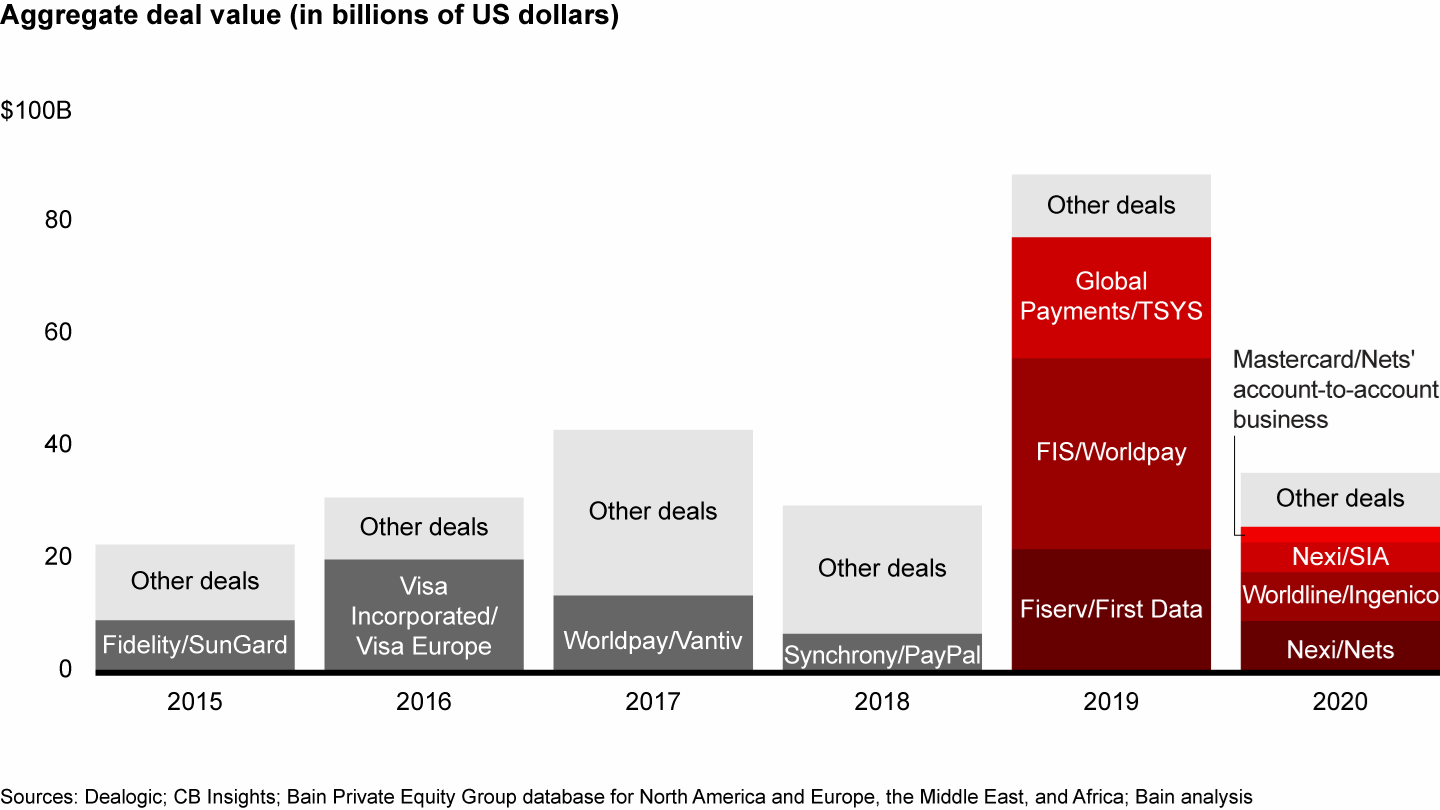M&A Report

한눈에 보기
- Deal value in 2020 for payments M&A could not match the record performance of 2019 (thanks to megadeals), but it was comparable with 2017–2018 despite Covid-19.
- Consolidation is at the heart of much of the M&A activity as larger players group together to achieve unsurpassed scale and substantial cost advantages.
- The payments sector is witnessing the rise of the regional powerhouse, especially in Europe, where France’s Worldline and Ingenico merger will create the continent’s largest payments provider. The announced Nexi deals for Nets and SIA are further evidence.
- Beyond megamergers and regional consolidation, there is a clear trend toward large payments players diversifying into adjacent areas.
While the Covid-19 pandemic had a big influence on M&A activity in many industries, in payments, deal activity has remained brisk. The proportion of deal value represented by trade buyers has substantially increased, while the proportion of deal value by financial investors has decreased. The sector experienced a wave of scale-driven consolidation; scope M&A has been active as well, with larger firms looking to bolt on new capabilities and products to enhance their core businesses, especially those under price pressure.

Financial Services: Why Europe’s M&A Season is Back in 2021
Join us on March 25, to discuss why M&A will be a bankable lever for growth in financial services, and how firms can prepare to get ahead.
The year 2019 introduced the payments megamerger (see Figure 1). While the number of deals stayed roughly the same, the average deal size rose fourfold, from $400 million in 2015 to around $1.6 billion in 2019, for the highest annual aggregate payments sector deal value in history. While there were some large deals in 2020, such as the Worldline and Ingenico merger as well as the announced Nexi deals for SIA and Nets, the total deal value was not enough to match the strength of 2019.
2019 was an outlier year; deal values have fallen back in 2020


Bulking up regional scale, and generating synergies
The three biggest mergers of 2019 (Fiserv and First Data, FIS and Worldpay, Global Payments and TSYS) were all rooted in a combination of bulking up regional scale (and to some extent global scale) and joining forces to generate synergies—both scale-driven cost synergies and capability- or cross-sell–driven revenue opportunities.

Financial Services: Why Europe’s M&A Season is Back in 2021
Join us on March 25, to discuss why M&A will be a bankable lever for growth in financial services, and how firms can prepare to get ahead.
This trend continued in 2020, most notably with the Worldline and Ingenico merger, which not only created Europe’s largest payments provider but also gave birth to a potential new global player in the e-commerce space, although it will take time to build a global presence from the constituent parts of the new group.
Regional consolidation is in full swing, especially in Europe. The announced deals to merge Italian payments leader Nexi with SIA in Italy and Nets in the Nordics pave the way for a handful of large players to lead on a regional basis. Nets itself had already been pursuing this approach via its 2018 deal with Concardis in Germany.
The rise of a new class of mega-acquirer with sufficient buying power to exert influence over other parts of the cards ecosystem raises challenges for suppliers.
The consolidation activity in payments is more mergers than acquisitions. In many cases, the buyer and seller are of similar size, with both players grouping together to achieve unsurpassed scale and substantial cost advantages. The rise of a new class of mega-acquirer with sufficient buying power to exert influence over other parts of the cards ecosystem raises challenges for suppliers to the business.
The need to diversify pure play payments firms
Large players are diversifying through scope acquisitions, with Visa and Mastercard leading the charge by expanding into a wide range of adjacent services (security, cross-border business to business, open banking, and alternative rail payments). These transactions tend to be small in value, but they signal a need to expand services beyond traditional core businesses that are under significant price pressure. For example, expanding into security services was the impetus behind Visa’s purchase of Verifi as well as Mastercard’s acquisition of Ethoca.

M&A in Payments: Megamergers and Consolidation
As larger players group together to form regional powerhouses, smaller players will find it harder to compete.
Consolidation will continue as smaller players find it harder to compete
We expect to see the wave of consolidation continue over the next three to five years as the underlying catalysts are likely to remain unchanged and as subscale players find it increasingly difficult to compete on their own. This will be especially relevant in a post–Covid-19 world. For example, the pandemic has hastened the adoption of e-commerce. As a long-term result, smaller point-of-sale–focused acquirers with a shrinking share of overall consumer payments will feel pressure to consolidate.